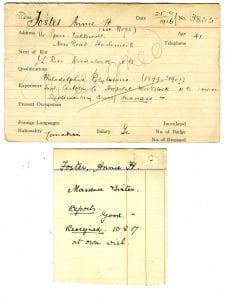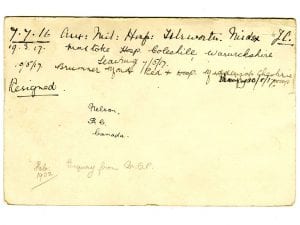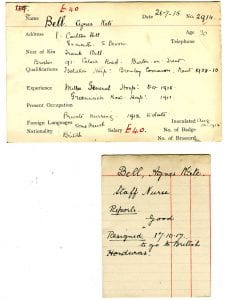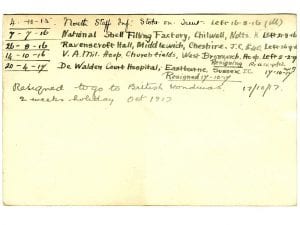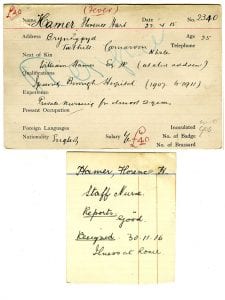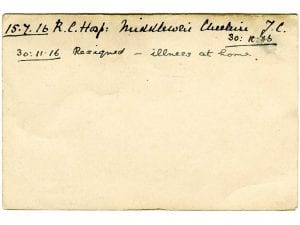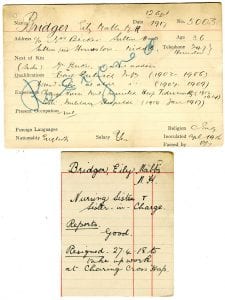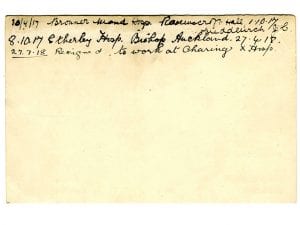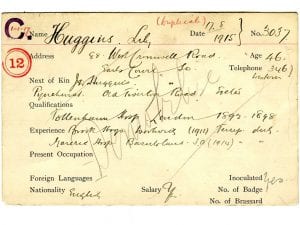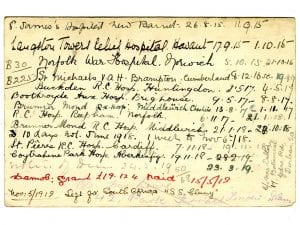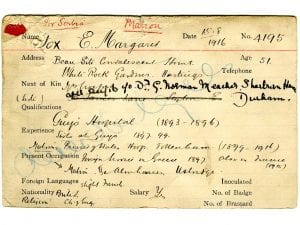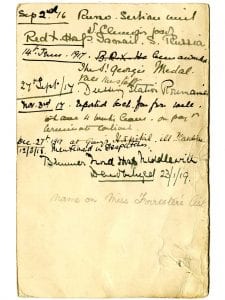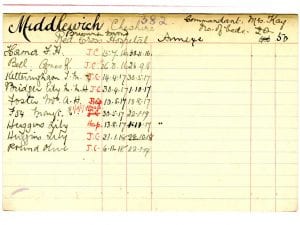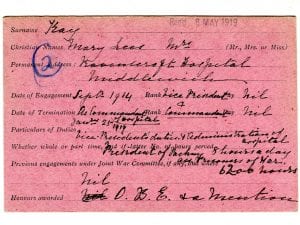BRITISH RED CROSS

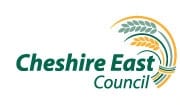
This section is what we know so far about the Middlewich Branch of the British Red Cross. This section includes the British Red Cross Information on the standard set up of hospitals during WWI, images of the British Red Cross service records of some of the staff that worked at the Brooks Lane Hospital. We have also gathered local information on what we know about the activities of the Middlewich Branch.
No photographs have been found at present of the ICI clubhouse being used as a hospital, but a photograph does appear with ICI staff pictured outside their new clubhouse. If anyone has any further information we would like to hear from you…
With thanks to : British Red Cross Society
Taken from the book, Middlewich 1900-1950 by Allan Earl.
The Middlewich Branch of the Red Cross Society was behind many events raising funds local, initially helping to raise funds for Belgian refuges in 1914. A shop opened in Middlewich, Hightown under the guidance of Mrs Kay of Ravenscroft Hall. Teams of knitters were engaged for helping soldiers overseas, as well as fundraising exhibitions, events, competitions and coffee evenings. When Brunner Mond offered the new clubhouse in Brooks Lane for the Red Cross Society to use as a hospital, attentions turned to raising much needed funds to run it.
‘The billiard room was reorganised to hold 10- 12 beds and ancillary rooms were to be used as store rooms or treatment and the storage of equipment. At the same time Dr Murphy was called up for the RAMC, to be posted almost immediately to the front. However before he left, he and Dr Hislop (who at this stage remained in Middlewich), together with the Red Cross, arranged for free medical treatment and free medicine to be given to the dependants of the soldiers and sailors away from home should they require it.
Just before Christmas 1914 the first 12 wounded men arrived at the Brooks Lane Hospital. They were from different regiments and from all parts of the country. The local people once again responded to requests for help and arrived at the hospital with milk and potatoes and Col. France Hayhurst sent rabbits from the estate. The men were cared for by 20 Red Cross nurses working on a rota system under the direction of Dr Melville’. (Page 78)
Concerts, dances and whist drives were arranged regularly, the entire proceeds being devoted to the War Relief Fund or the Red Cross Hospital Fund.
The local farmers, who were during this time in a milk dispute with Anglo-Swiss, decided to make the milk into cheese and have a cheese fair to raise funds for the hospital, which totalled £180.
By 1916, two hospitals were supported by fundraisers in Middlewich, Brooks Lane and Ravenscroft Hall which was used for convalesce. It was reported that the Harvest Festival produce was donated to the hospitals plus profits from events.
In August 1917 a croquet tournament was held at Ravenscroft Hall with several convalescing Soldiers taking part.
Records also show that a fete was held in the Council School on New Year’s Eve 1917, 6-700 people attended with the main hall and some of the classrooms had a very festive appearance. The plants decorating the rooms were lent by Mr Boosey. Several patients from the Red Cross Hospital helped in the decoration.
‘Brooks Lane Hospital was closed on January 21st 1919, the Duchess of Westminster visited the hospital to give a personal ‘thank you’ to Mrs Kay, the nursing staff and the band of workers that had spearheaded the fundraising and donations.
682 men had been nursed back to health at both hospitals. Mrs Kay was awarded the OBE for her leadership and work with the Red Cross in Middlewich’. (Page 101)
Permission of use of material is for the purpose of helping to produce a book on hospitals in the First World War and is not to be used for any other purpose.
thanks to : British Red Cross Society
HOSPITALS IN THE FIRST WORLD WAR
BRITISH RED CROSS ACTIVITY DURING THE FIRST WORLD WAR
Following the outbreak of war in August 1914, the British Red Cross formed the Joint War Committee with the Order of St John to pool fundraising activity and resources and work together under the protective emblem of the Red Cross.
Members of the British Red Cross and the Order of St John were organised into Voluntary Aid Detachments. The term VAD was also used for an individual member as well as a detachment. All members were trained in first aid and some undertook training in nursing, cookery and hygiene and sanitation.
Throughout the war VADs worked in hospitals, convalescent homes, rest stations, packing centres, medical supply depots and work parties. The Joint War Committee organised the volunteers alongside technical and professional staff. It also supplied the machinery and mechanisms to provide these services in Britain and in the conflict areas of Europe, the Middle East, Russia and East Africa.
Just before the declaration of war, the numbers of Voluntary Aid Detachments raised by the British Red Cross and the Order of St John and registered by the War Office were as follows:
| Detachments | Personnel | |||
| British Red Cross | St John | British Red Cross | St John | |
| Women | 1,582 | 241 | 40,018 | 6,773 |
| Men | 408 | 143 | 17,666 | 5,865 |
| Total | 1,990 | 384 | 57,714 | 12,638 |
By the time that the Armistice was called in 1918 these figures had increased significantly:
| Detachments | Personnel | |||
| British Red Cross | St John | British Red Cross | St John | |
| Women | 2,534 | 713 | 66,211 | 24,440 |
| Men | 560 | 276 | 24,712 | 10,630 |
| Total | 3,094 | 989 | 90,923 | 35,070 |
Auxiliary hospitals and convalescent homesDuring the War the British Red Cross provided auxiliary hospitals and convalescent homes for wounded service men. During peacetime the British Red Cross had been preparing for this. It had already secured buildings, equipment and staff so that many temporary hospitals were available for use as soon as wounded men began to arrive from abroad.
Despite this preparation, on the outbreak of War both the Joint War Committee and the War Office were inundated with additional offers of buildings. It was the Committee’s job to sort through these 5000 offers to assess the suitability of the premises for use as temporary hospitals. The buildings on offer varied greatly including town halls, schools, large and small private houses, both in the country and in towns and cities. Those deemed suitable by the Commission were established as auxiliary hospitals. These were attached to Central Military Hospitals, which directed the movement of the patients, who remained under military control.
In all, there were over 3000 of these hospitals, which were administered under County Directors. They were usually staffed by:
> a Commandant, who was in charge of the hospital, except for medical and nursing services;
> a Quartermaster, who was responsible for the receipt, custody and issue of article in the provision store;
> a Matron, who directed the work of the nursing staff;
> members of the local Voluntary Aid Detachment, who were trained in first aid and home nursing.
In many cases ladies in the neighbourhood gave part-time service, although it was often necessary to supplement voluntary work by paid labour, such as in the case of cooks. Medical attendance was provided locally and was usually voluntary, despite the extra strain that the medical profession was already under at that time.
The patients at these hospitals were generally the less seriously wounded and those in need of convalescence. The servicemen preferred the auxiliary hospitals as the discipline was not as strict as in the Military Hospitals, conditions were less crowded and the surroundings more homely.
MOTORISED AMBULANCES
The Joint War Committee was the first to supply motorised ambulances to the battlefields. The first convoy arrived in France in September 1914 and proved much more effective in the war terrain than the horse drawn ambulances used in previous conflicts.
The ‘Times Appeal’, issued on 2 October 1914, was instrumental in raising funds for the provision of ambulances. A successful response led to sufficient funds within 3 weeks to purchase 512 Ambulances. The Red Cross bought practically every chassis in the country that was suitable for the purpose.
There were additional appeals, the ‘Dennis-Bayley Fund’ and ‘Transport of Wounded Fund’ which helped maintain the upkeep of the vehicles and there were also a number of Cars presented as gifts to the Society.
Each ambulance carried on average 3939 cases and each driver on average 3000 cases. A total of 2500, both male and female, drivers served.
TRAINS
The UK Flour Millers’ Association presented the Red Cross with two ambulance trains, specially built and equipped, constructed by Great Western and Great Eastern Railways. The trains were working in France during 1915, with another train, converted from ordinary French rolling stock. The three trains carried 461,844 patients.
WORK PARTIES
Work parties were set up by voluntary groups across the country to help supply hospitals with such items as bandages and clothing. Queen Mary’s Needlework Guild (QMNG) was one of many voluntary organisations founded at the start of the First World War to supply gifts and comforts to troops in the field and to sick and wounded soldiers in hospitals at home and abroad. These included pyjamas, bed-jackets, bed-socks, operation stockings, bags, bandages and dressings.
During the war the Queen Mary’s Needlework Guild worked as part of the War Hospitals Supply Depot providing bandages and other items for military hospitals. Work parties who worked as part of the Joint War Committee of the British Red Cross and Order of St John supplied similar items to auxiliary voluntary hospitals.
QMNG worked alongside work parties co-ordinated by the Joint War Committee of the British Red Cross and Order of St John and work parties co-ordinated by a special department of the War Office.
WORK AT HOME
The British Red Cross established offices to deal with enquiries for the missing in Paris, Boulogne and London in the early stages of the War. An office was set up in London before the end of 1914. It began on a small scale at 83 Pall Mall and then the London office of the Wounded and Missing Department was opened at 20 Arlington Street, lent by Lord Salisbury, in April 1915 with a staff of about twenty voluntary workers, besides typists and this became the clearing-house for all enquiries received from the public and also for all reports collected by the searchers in hospitals at home and abroad.
All incoming enquiries were registered in the office and included in the printed monthly enquiry list, which was distributed to all searchers and the searchers’ reports, as they were received, were communicated to the enquirers.
The department continued to grow and moved to Norfolk House, St James Square in July 1915 and then to 18 Carlton House Terrace in November 1915, lent by Lord Astor, where it remained until the end of the war. Sir Louis Mallet was the Director of the Department from April 1915 to September 1916 succeeded by the Earl of Lucan from September 1916 to the close of work in March 1919.
In October 1916, the section of the department which dealt with prisoners of war was removed to form part of the newly-constituted Central prisoners of War committee and from that time onwards, all matters referring to prisoners of war was handed over to that committee.
The War Office largely regulated the scope of the work from the beginning. Facilities were given to the Wounded and Missing department for visiting the hospitals and consulting the War Office records, but it was not officially recognised until July 1915, when it was stated that we should be the only organisation permitted to make such enquiries for the missing and the work carried on in close liaison with the Casualty department of the War Office.
In July 1916 the Department started to make enquiries for all the missing, whether or not friends or relatives had made a special application. It was judged best to begin enquiring for every missing man as soon as he was so reported. The War Office supplied the Department with an annotated copy of the daily communiqué of casualties, giving the details essential for search (but omitted from the published casualty lists) of the missing man’s battalion and company, with the date of the casualty. The Wounded and Missing included all these names in their enquiry list and therefore often had information to hand when the family of the missing man made an enquiry. The War Office, in letting the next-of-kin about a casualty, they automatically referred them to us for further information.
The searching of hospitals at home started in 1915 and was gradually developed all over the country. The different districts were placed under the charge of a head searcher. That person, usually a local volunteer, was responsible for seeing that the first-line hospitals, which were those receiving wounded direct from France, were searched and every new draft of wounded were questioned with regard to the missing of the list.
Regular searches in the base hospitals and army rest camps abroad and hospitals at home, about 1200 searchers were employed in the UK, meant a very wide circulation of the monthly enquiry list. After the Armistice, searching was carried out with very good results at the various reception camps in France and England, to which repatriated prisoners of war were first sent.
‘Wounded’ enquiries were referred to the War office or to the regimental record offices and reports on the wounded man’s condition, where the hospital was known, were obtained by telegram from the hospital searcher. ‘Missing’ enquiries were classified according to the front on which the man was missing and passed to the section that prepared the monthly list for printing.
Another section of the office checked the periodical lists received direct from Germany through the Frankfurt Red Cross, of those reported prisoners of war, in order that their names be removed from the next enquiry list. All enquiries relating to men in the forces in Italy and the East were dealt with in a separate section, as were all enquiries for officers in France.
It soon became established in writing to relatives waiting for information about the ‘missing’ that official forms and methods should be discarded, so that each enquirer might feel that a certain personal interest was taken in his or her case. During the War the Department received 342,248 enquiries.
In August 1914, two or three Red Cross workers began to collect lists of wounded in the hospitals and to answer enquiries received at the Paris Red Cross Headquarters. In addition to making enquiries in hospital, Lord Robert Cecil visited the Villers Cotterets district in order to find and mark graves. Arrangements were made for various visitors to collect daily lists of admissions to hospitals in Paris and the neighbourhood. Lists of admissions were also received from the French Government. The casualty list from the Times was also put on a card index and all enquiries checked against it. Letters addressed to soldiers picked up on the Marne battlefields were brought to the office and they undertook to return them to the writers.
On 20 October the office moved from a room in a hotel into rooms at No 23 Rue de la paix. The Army Agents occupied the same building and were also receiving enquiries. A joint list of names was telegraphed daily to the Deputy Adjutant General, 3rd Echelon at Nantes, asking whether a casualty had been reported. The 3rd Echelon was the branch of the General Headquarters in France which dealt with records, casualties and reinforcements.
The first list of British prisoners, containing 128 names, was received on 28 November 1914 from the United States Consul-General in Paris. Later these lists came from the Geneva Red Cross, twice a week, as they were received from Germany. Information was sent direct to the relations, often reaching them ten days before it was received from the War Office.
In November 1914, the editor of the Evening News advertised every day in his paper, long lists of names, headed ‘Where Are These Men?’ and these lists were brought to the Paris Office in order to obtain information.
Another branch of work consisted of tracing graves. An additional Red Cross unit started operations in the North and communicated with the Boulogne office. Towards the end of March 1915, the whole of the graves work was taken over by the War Office.
A watching list was also used in all offices in France; admission to hospitals in all areas could be checked against it and relations of sick and wounded officers who chose to register their name could be informed immediately of the location and condition of the patient. There were over 1500 names on the list.
The Paris office ceased to exist on 5 June 1915 as the hospitals in the area had closed.
An office opened in Boulogne on 1 November 1914 and was transferred to the Hotel Christol on 30 May 1915. The office began with three searchers and grew to twelve by October 1917. The Military authorities in Hospitals and camps gave assistance where they could, for example the Deputy Director of Medical Services made telephone enquiries from casualty clearing stations and hospitals with which the Department could not communicate. The office was closed on 22 February 1919. During the War there were also offices in Rouen, Le Treport, Etaples, Havre, Calais and Marseilles.
By the end of the war the British Red Cross had:
> provided 90,000 VADs who had been mobilized to work at home and abroad
> established 1786 auxiliary hospitals
> provided and staffed ambulances, hospital trains and motor launches
> dispatched over 47,000 food parcels a month
> supplied 4,000,000 books through the Red Cross War Library
> raised £21,885,035
> spent £20,058,355 on hospitals, medicine, clothing and aftercare to the sick and wounded.
The names of many personnel who lost their lives are recorded on war memorials throughout the country and overseas. In 1920 the British Red Cross War Medal was instituted and awarded to some 41,000 members who had served in the United Kingdom between 1914 and 1919 and were not eligible for British military medals.
1909 scheme for the organisation of voluntary aid in England and Wales
The scheme for the organisation of voluntary aid in England and Wales defined the British Red Cross’ role in assisting the government in wartime by providing supplementary aid to the territorial medical service was granted on 16 August 1909. A similar scheme for Scotland followed in December 1909.
WHY WAS IT NEEDED?
The Territorial and Reserve Forces Act 1907 reformed the reserve forces of the British Army by transferring existing volunteer and yeomanry units into a new territorial force and by redesignating units as part of the Army Reserve.
Part 1 of the act defined the position of the county Branches of the British Red Cross, to work with their respective county territorial associations. The scheme laid down the terms by which the organisation would work with the Territorial Army.
WHO WAS INVOLVED?
The executive committee appointed a small committee to consider the situation with the director-general of the Army Medical Service. The executive committee sent a copy of the scheme to every president, vice-president, honorary secretary and committee member of each county Branch. Colonel Sir James Magill was appointed organizing secretary.
WHAT HAPPENED AS A RESULT OF THE SCHEME?
As a result of the scheme, the Red Cross organised voluntary aid detachments (VADs), made up of men and women, in every county to carry out transport duties and staff rest stations and hospitals.
The Red Cross selected suitable buildings for general hospitals, prepared schedules of equipment for the hospitals and submitted schemes to establish auxiliary hospitals and convalescent homes for wounded servicemen.
Each county Branch appointed a county director to be in charge of raising detachments. All VAD members were to be trained in first aid and nursing through St John Ambulance Association. Volunteers were also trained to make use of local resources to improvise stretchers and other methods of transport, and to convert local buildings into shelters and rest stations for the sick and wounded. By October 1910, 202 detachments had been registered with over six thousand volunteers.
An amended scheme was published in December 1910, which gave county associations authority to employ other means of raising detachments, including registering with the St John Ambulance Brigade and St John Ambulance Association units. A few territorial force association detachments were also raised.
In March 1911, a sub-committee recommended uniforms which would readily distinguish the wearers as belonging to the Red Cross detachments, but which would not appear to be too military.
Membership of the Detachments grew still further on the outbreak of the First World War in 1914. The British Red Cross and the Order of St John, a body that was also empowered to raise detachments under the War Office Voluntary Aid Scheme, combined to form the Joint War Committee. This Committee administered the joint wartime fundraising and relief work with the greatest possible efficiency and economy, under the protection of the Red Cross emblem and name.
During the First World War the Joint War Committee administered over 3000 auxiliary convalescent hospitals in Britain staffed by local Voluntary Aid Detachments. As the war progressed and more men were called up for military service, female VADs took on new roles including ambulance drivers, cooks, clerical workers and telephonists.
A further revised scheme was issued in 1923. Detachments could again consist of men or women, but the service was to be of two kinds:
> mobile – where on mobilisation members would be expected to go wherever their services were needed
> immobile – where they would carry out their duties from their own homes.
The Voluntary Aid Detachments formed part of the Technical Reserve of the Forces of the Crown.
In addition, British Red Cross detachments were raised and trained to accommodate those wanted to help but who could not give the commitment required by membership of the Voluntary Aid Detachments. The Red Cross detachments were intended to provide and replenish the personnel of the Voluntary Aid Detachments, to supply a reserve in time of emergency and to carry out the duties of a National Red Cross Society.
VADs continued to be at the core of voluntary services until the reorganisation of the Red Cross in 1984.
ROLE OF THE BRITISH RED CROSS
One of the many important services that the British Red Cross provided during the First World War was the provision of auxiliary hospitals and convalescent homes for wounded service men. The British Red Cross had prepared for this and had already found some suitable properties that could be used as hospitals should conflict occur. However, it was not anticipated that this service would play such an important role in the recuperation of so many service men.
Following the outbreak of the First World War, the British Red Cross and the Order of St John of Jerusalem joined together to form the Joint War Committee to pool their resources of money and manpower with maximum economy and efficiency under the protection of the Red Cross emblem. As the British Red Cross had already secured buildings, equipment and staff, many temporary hospitals were largely available for use as soon as wounded men began to arrive from abroad.
Despite the pre-war preparation, on the outbreak of war both the Joint War Committee and the War Office were inundated with additional offers of buildings for accommodation. It was the Committee’s job to sort through these 5000 offers of premises to assess their suitability for use as a temporary hospital. The buildings on offer were varied and included anything from town halls and elementary schools to large and small private houses, both in the country and in towns and cities. Those deemed suitable by the were established as auxiliary hospitals. These were attached to Central Military Hospitals, which directed the movement of the patients, who remained under military control.
In total there were over 3000 of these auxiliary hospitals, which were administered under County Directors. They were usually staffed by:
> a commandant, who was in charge of the hospital except for medical and nursing services
> a quartermaster, who was responsible for the receipt, custody and issue of articles in the provision store
> a matron, who directed the work of the nursing staff
> members of the local Voluntary Aid Detachment, who were trained in first aid and home nursing.
In many cases ladies in the neighbourhood gave part-time service, although it was often necessary to supplement voluntary work by paid labour, such as in the case of cooks. Medical attendance was provided locally and was usually voluntary, despite the extra strain that the medical profession was already under at that time.
The patients at these hospitals were generally the less seriously wounded and those in need of convalescence. The servicemen preferred the auxiliary hospitals as the discipline was not as strict as in the Military Hospitals, conditions were less crowded and the surroundings more homely. It was partly their popularity and reputation for an excellent standard of care which, during the Second World War, was to lead to the extension of these convalescent services to include the provision of a broad range of rehabilitation therapies.
RECORDS OF AUXILIARY HOSPITALS
It is possible to learn from the records a great deal about this aspect of the care for the wounded during the First World War, the improvised hospitals and the vast number of women who undertook what was for many a completely new type of work. There is however no information about the individual patients.
> Reports by the Joint War Committee and the Joint War Finance Committee of the British Red Cross Society and the Order of St John of Jerusalem in England on voluntary aid rendered to the sick and wounded at home and abroad and to British prisoners of war 1914-1919. This volume contains information about auxiliary hospitals and a list of hospitals by county in the appendices
> List of the various hospitals treating military cases in the United Kingdom. Entries are arranged under the different Military Command areas of the country and give the location and size of each establishment. Auxiliary hospitals are included, together with military and civil hospitals. The affiliation between central and auxiliary hospitals is shown on this list.
> Accounts of the work of some hospitals were published at the time in the annual reports of county branches of the British Red Cross.
> Reports covering the work undertaken were compiled and produced at the end of the war by the following counties: Berkshire; Cambridgeshire; Cumberland and Westmorland; Devon; Gloucestershire; North East and East Lancashire; Glamorgan; Hampshire; Kent; London; Monmouthshire; Norfolk; Shropshire; Sussex; East of Scotland. They give descriptions of the work of the local hospitals, often with photographs of the buildings and staff. Some have lists of the VAD staff.
The County Branches: their organization and work during the first months of the war, volume I. This book contains brief accounts of the early work of auxiliary hospitals in Bedfordshire, Berkshire, Birmingham, Bristol, Buckinghamshire, Cambridgeshire, Cheshire, Cornwall, Derbyshire, Devonshire, Dorset, Durham, Essex and Gloucestershire. Unfortunately the projected second volume of this work did not appear.
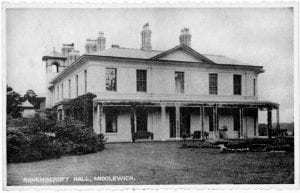 This article features staff records cards from Ravenscroft Hall when it was a Red Cross Hospital Annexe.
Thumbnail images of the cards are shown below. To view full size just click on the thumbnail image
This article features staff records cards from Ravenscroft Hall when it was a Red Cross Hospital Annexe.
Thumbnail images of the cards are shown below. To view full size just click on the thumbnail image
